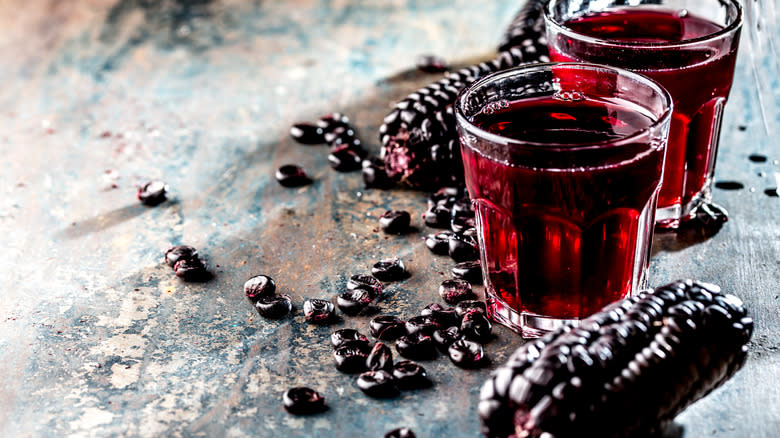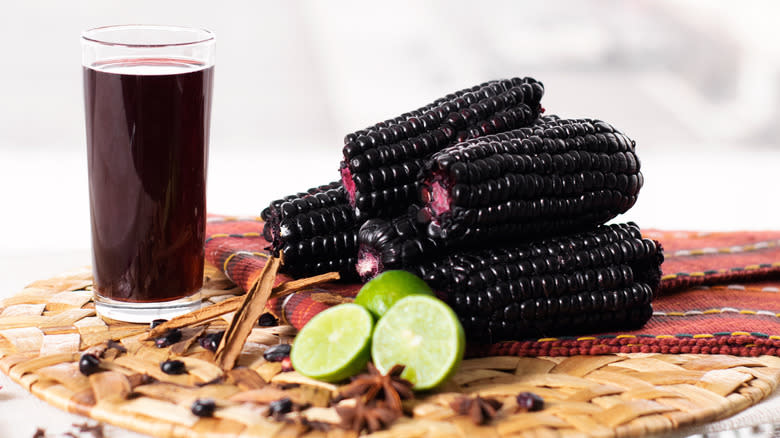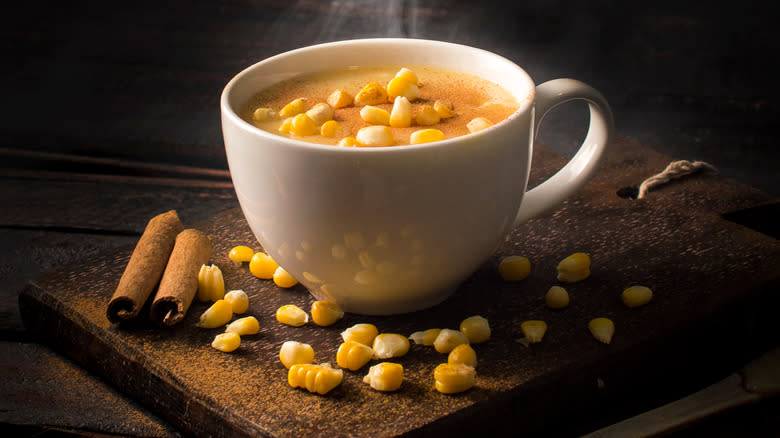Seriously, You Need To Try Drinking Corn Juice This Summer

Not so long ago, green juice was all the rage, turning all the goodness of green vegetables, like spinach and celery, into an easy-to-drink beverage. Orange juice has been a breakfast favorite for decades, and lime and lemon juices are staple ingredients in any kitchen or home bar. But corn juice? To many in the U.S., it might sound a little odd. Corn juice, however, has a long history in other parts of the world, and it might be precisely what you need to try this summer.
There are several ways that you might find corn juice prepared, including the straightforward method of boiling sweetcorn kernels with some sugar, then cooling and blending before chilling and serving. There's also corn milk, which comes from the cob instead of the kernels and is the unexpected addition your coffee needs — and is often used as an ingredient in soups and sauces as well as in drinks.
Corn juice isn't just a way to get maximum enjoyment out of the summer's crop of sweetcorn, either. There are several other kinds of corn juice that are a little more unique, and this requires taking a look at the traditions of Central and South America. It is also one idea that you might want to hold onto when October rolls around, and if you're wondering why, it's because there's a certain kind of corn juice that's often described as looking very much like blood.
Read more: The 14 Best Sugar-Free Sodas Ranked
Corn Juice Has A Long History In The Americas

When it comes to the countries that eat the most corn, it's unsurprising that those in the Americas are top of the list. The vital foodstuff was developed around 10,000 years ago in what's now southern Mexico. But for the ancient practice of drinking corn juice, let's hop over to Peru. Archaeologists say that chicha morada — a drink once made with only corn and pineapple — was developed around 5,000 years ago. It's still popular today, and because it's made with a blackish-purple kind of corn, it's the kind of color that might make the perfect beverage for your next Halloween party. Today, chicha morada is typically made with more than just corn and pineapple. Since the arrival of European explorers and the introduction of various spices, the flavors of cinnamon and cardamom are often added for a refreshing summertime drink.
That's not the only corn juice that's been popular for centuries, and atol de elote is a corn drink with a more familiar yellow color. This version has long been popular in countries such as Honduras and El Salvador and dates back to the Mayans. Interestingly, it was such a big deal that it was mentioned in Hernan Cortes's writings. He noted that its original form wasn't precisely to European tastes. What exists today is somewhat in the middle: Corn remains the crucial ingredient, but the addition of spices brings it up to date.
Store-Bought Or Homemade, Corn Juice Is An Absolute Win

So, where can you source corn juice? In the most basic form, it's easy to make: Cook, puree, and strain corn. While that's certainly a fine and legitimate option, anyone feeling adventurous should opt for sourcing legit chicha morada and atol de elote.
Chicha morada is often described as being slightly sweet, a little sugary, kind of nutty, and thanks to the spices that are now used in the drink's preparation, it takes on a flavor similar to spiced wine. Imagine a mulled wine heavy on grapes, and you're close to the taste of chicha morada. For anyone interested in trying the real thing, it's widely available in both a liquid and powdered form. Check the international section of your go-to grocery store or any Latin specialty market, or order it online.
Atole de elote is often served hot and has a much different flavor profile thanks to the addition of other ingredients like vanilla. It's also much thicker than chicha morada, and if you love the Peruvian corn juice for the summer, you'll love atole de elote in the winter. Imagine a thick, drinkable corn porridge, and you're pretty close to what it tastes like. This drink, too, can be sourced with some determination: Check Mexican grocers, the international section of your grocery store, or order packets of instant mix online.
Read the original article on The Daily Meal.


